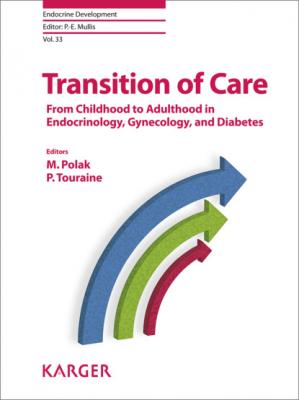Transition of Care. Группа авторов
Чтение книги онлайн.
Читать онлайн книгу Transition of Care - Группа авторов страница 2
 (Chestnut Hill, MA); Pitteloud, N. (Lausanne)
(Chestnut Hill, MA); Pitteloud, N. (Lausanne)
Léger, J. (Paris)
Pedersen, A.T.; Cleemann, L.; Main, K.M.; Juul, A. (Copenhagen)
Fertility Preservation in Endocrine Disorders during Transition for Girls
Bénard, J. (Bondy/Bobigny); Sermondade, N. (Bondy); Grynberg, M. (Bondy/Bobigny/Paris)
Fertility Preservation in Klinefelter Syndrome Patients during the Transition Period
Rives, N.; Rives, A.; Rondanino, C.; Castanet, M.; Cuny, A.; Sibert, L. (Rouen)
Transition can be defined from physiological changes during the period from the end of puberty to the attainment of an adult phenotype. This gives the length of transition as approximately 5–10 years depending on the patient, although it may be longer or shorter depending on multiple factors. Alternatively, transition can be seen as the point in time when the patient can no longer be seen by the pediatrician and is asked to make the next appointment with an endocrinologist for adults. However, focusing on a single time point is not the best way to handle this process for a patient because the transition from pediatric care to the adult one needs to be structured. A large number of patients with chronic diseases drop out of therapy during the transition period. Multiple factors are associated with this, such as lack of understanding of the disease process, insufficient knowledge of treatment options, the patient becoming more independent, and the requirement for interaction with a new set of health care workers. Education regarding disease management and treatment options should be provided from an early age and through the transition period.
However, endocrine specialists will view the transition period differently, depending on whether they are pediatric endocrinologists, who mainly deal with congenital diseases in which auxology is important, or adult endocrinologists, who are more concerned with body composition and metabolic factors.
In this textbook, key leaders on different topics present their viewpoints as a pediatric and/or an adult endocrine specialist, most referring to a case study outlining practical aspects of transition. This textbook presents different approaches to patients with chronic diseases, either rare or not, during the transition period.
We definitely hope that this textbook will be helpful for the reader in front of a patient during the transition period and foster the development of specific health care pathways dedicated to the patient during this key period of life.
Philippe Touraine, Paris
Michel Polak, Paris
General Concepts
Polak M, Touraine P (eds): Transition of Care: From Childhood to Adulthood in Endocrinology, Gynecology, and Diabetes. Endocr Dev. Basel, Karger, 2018, vol 33, pp 1–9 (DOI: 10.1159/000487521)
______________________
Challenges of the Transition from Pediatric Care to Care of Adults: “Say Goodbye, Say Hello”
Philippe Tourainea · Michel Polakb
aCentre de Référence des Maladies Endocriniennes Rares de la Croissance et du Développement des Pathologies Gynécologiques Rares, Institut E3M-ICAN, Hôpitaux Universitaires Pitié-Salpêtrière Charles-Foix, Médecine Sorbonne Université, and bPediatric Endocrinology, Gynecology and Diabetology, Centre de Référence des Pathologies Gynécologiques Rares et des Maladies Endocriniennes Rares de la Croissance et du Développement, Hôpital Universitaire Necker Enfants Malades, Université Paris Descartes, Paris, France
______________________
Abstract
Transition has been defined as “the purposeful, planned movement of adolescents and young adults with chronic physical and medical conditions from child-centered to adult-oriented health care systems.” We will here describe the challenges of such a process: challenges coming from the pediatrician, from the adolescent, linked to the disease itself, and those from the parents. We will outline how to overcome those fears and challenges to provide a successful transition process. A key factor to underline that process is that a relationship based on confidence should be established between the pediatrician and the physician for adults, in order for that relationship, based on trust, to be the basis for the transfer of the adolescent from the pediatric system of care to the adult one.
© 2018 S. Karger AG, Basel
There is evidence that the process of transition from pediatric (child) to adult health services is often associated with deterioration in the health of adolescents with chronic conditions [1–8]. Transitional care is the term used to describe services that seek to bridge this care gap. It has been defined as “the purposeful, planned movement of adolescents and young adults with chronic physical and medical conditions from child-centered to adult-oriented health care systems.” In order to develop appropriate services for adolescents, evidence of what works and what factors act as barriers and facilitators of effective interventions is needed.
Defining Characteristics of Transition and Transfer
The population of interest within this paper is children and young people (aged around 10–20 years) who are afflicted by a chronic condition requiring life-long specialized care. The broad range of medical and psychosocial conditions with a congenital and/or chronic nature is in fact in the scope of this paper, ranging from somatic to psychological and neurodevelopmental conditions. This group of conditions can be defined as “any medical condition that can be reasonably expected to last (unless death intervenes) and to involve either several different organ systems or one organ system severely enough to require specialty pediatric care and probably some period of hospitalization in a tertiary care center” [9].
Transition refers to the process followed by young persons with chronic conditions in order to take charge of their health and lives in adulthood [10]. This process entails interventions, such as providing structured and repetitive patient education, counseling services of patients regarding lifestyle issues and health behaviors, and care and skill demonstration provided by transition